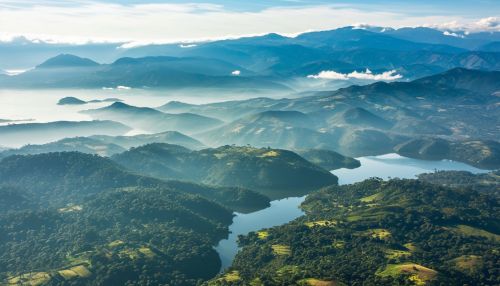Colombia
Geography
Colombia, officially known as the Republic of Colombia, is located in the northwestern part of South America. It is bordered by five countries: Venezuela to the east, Brazil to the southeast, Peru and Ecuador to the south, and Panama to the northwest. To the north, it has a coastline on the Caribbean Sea, while to the west, it borders the Pacific Ocean.


The country's geography is characterized by its six main natural regions, each with unique characteristics that have influenced the country's social and economic development. These regions are the Andean Region, the Caribbean Region, the Pacific Region, the Orinoquía Region, the Amazon Region, and the Insular Region.
Andean Region
The Andean Region, the most populated region in Colombia, is part of the Andes mountain range, which extends from Chile and Argentina in the south to Colombia in the north. This region is characterized by its high mountains, deep valleys, and plateaus. The Andean Region is further divided into three mountain ranges (or "cordilleras"): the Cordillera Occidental, the Cordillera Central, and the Cordillera Oriental.
Caribbean Region
The Caribbean Region is located in the north of the country, along the Caribbean Sea. It is characterized by its flat lands, sandy beaches, and coral reefs. The region is also home to the Sierra Nevada de Santa Marta, the highest coastal mountain range in the world.
Pacific Region
The Pacific Region is located on the western side of the country, along the Pacific Ocean. This region is known for its high rainfall, dense forests, and biodiversity. The Pacific Region is also home to the majority of Colombia's Afro-Colombian population.
Orinoquía Region
The Orinoquía Region, also known as the Eastern Plains, is located to the east of the Andean Region. This region is characterized by its flat, grassy plains, which are used primarily for cattle ranching and oil extraction.
Amazon Region
The Amazon Region is located in the south of the country, and it is part of the larger Amazon Rainforest. This region is known for its high biodiversity, indigenous cultures, and the Amazon River, the largest river by discharge of water in the world.
Insular Region
The Insular Region includes all of Colombia's islands, located in both the Caribbean Sea and the Pacific Ocean. This region is known for its coral reefs, marine biodiversity, and the unique culture of the Raizal people on the islands of San Andrés and Providencia.
History
Colombia's history can be divided into several periods: pre-Columbian, colonial, independence, and modern. Each period has left a significant impact on the country's cultural, social, and political development.
Pre-Columbian Period
Before the arrival of the Spanish in the 16th century, Colombia was inhabited by various indigenous groups, each with their own cultures, languages, and social structures. These groups included the Muisca, Quimbaya, Tairona, and many others.
Colonial Period
The Spanish colonization began in the early 16th century with the arrival of explorers like Alonso de Ojeda and Rodrigo de Bastidas. The Spanish established the New Kingdom of Granada, which included present-day Colombia, Ecuador, Panama, and Venezuela.
Independence Period
The struggle for independence from Spain began in the early 19th century, led by figures like Simón Bolívar and Francisco de Paula Santander. After a decade-long war, the Republic of Colombia (also known as Gran Colombia) was established in 1819, encompassing present-day Colombia, Ecuador, Panama, and Venezuela.
Modern Period
After the dissolution of Gran Colombia in 1831, the Republic of New Granada was established, which later became the United States of Colombia in 1863, and finally the Republic of Colombia in 1886. The 20th century was marked by periods of political violence, such as La Violencia (1948–1958), and armed conflict with guerrilla groups like the Revolutionary Armed Forces of Colombia (FARC) and the National Liberation Army (ELN).
Economy
Colombia's economy is the fourth largest in Latin America, after Brazil, Mexico, and Argentina. It is classified as an upper-middle-income economy by the World Bank and is part of the CIVETS group of leading emerging markets.
The Colombian economy is diverse and has a large primary sector, with industries such as mining, agriculture, and fishing playing a significant role. The country is the world's leading source of emeralds and a significant global player in gold, nickel, and coal production.
The secondary sector, including manufacturing and construction, is also a significant part of the economy. Major industries include food processing, textiles and clothing, metals and metal products, chemicals, shipbuilding, and automobile manufacturing.
The tertiary sector, including services and commerce, is the largest part of the Colombian economy, accounting for over 50% of GDP. Key areas include finance, real estate, tourism, and information technology.
Culture
Colombian culture is a fusion of many different influences, including indigenous, Spanish, African, and more recent immigrant cultures. This diversity is reflected in the country's music, dance, art, literature, and cuisine.
Music and Dance
Colombian music and dance styles are diverse and vary by region. Some of the most well-known styles include cumbia, vallenato, salsa, and reggaeton. Traditional instruments, such as the maracas, the tambora, and the accordion, play a significant role in Colombian music.
Art
Colombian art has a long history, from pre-Columbian gold and pottery artifacts to the contemporary works of artists like Fernando Botero and Óscar Murillo. The country is also known for its street art, particularly in the capital, Bogotá.
Literature
Colombian literature is rich and diverse, with renowned authors like Gabriel García Márquez, who won the Nobel Prize in Literature in 1982 for his magical realist novels.
Cuisine
Colombian cuisine varies by region, but common elements include maize, potatoes, meat, and seafood. Popular dishes include arepas, empanadas, bandeja paisa, and ajiaco.
